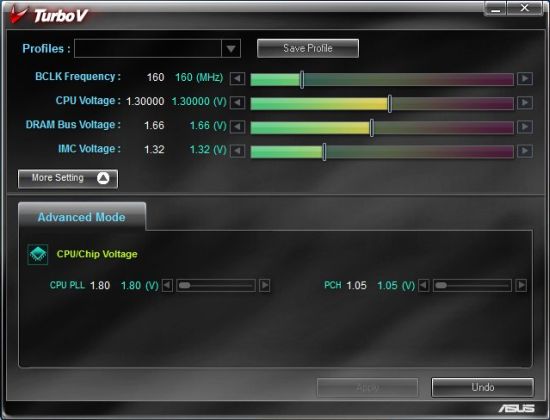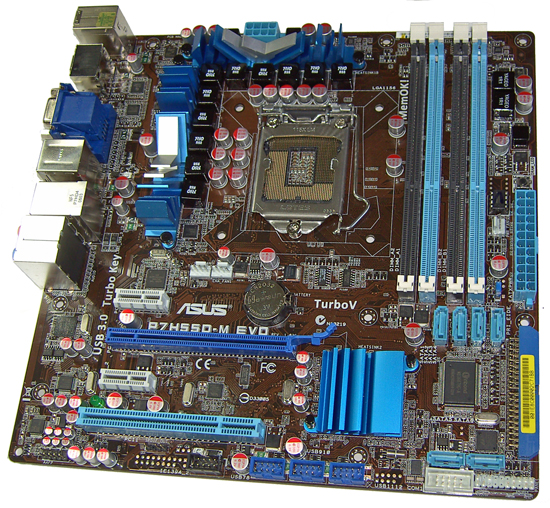Choosing the Best H55/H57 Motherboard - Part 1
by Rajinder Gill on January 31, 2010 11:30 PM EST- Posted in
- Motherboards
ASUS P7H55D-M EVO
The ASUS P7H55D-M EVO is currently priced at $135 at Newegg.
| ASUS H55D-M EVO | |
| Market Segment | H55 General Use/HTPC |
| CPU Interface | LGA-1156 |
| CPU Support | LGA-1156 i3/i5/i7 Series of Processors |
| Chipset | Intel H55 Express Chipset |
| BCLK Speeds | 80-500MHz in 1MHz increments |
| DDR3 Memory Speed | 800, 1067, 1333 Frequency Ratios |
| QPI Frequency | All supported mutlpier ratios available |
| Core Voltage | 0.85V ~ 1.70V in 0.00625V increments |
| CPU Vdroop Compensation | On/Off |
| CPU Clock Multiplier | Dependant on Processor, all available multipliers supported |
| DRAM Voltage DDR3 | Auto, 1.20V ~ 2.20V in 0.02V increments (1.50V base) |
| DRAM Timing Control | tCL, tRCD, tRP, tRAS, + 15 Additional Timings |
| DRAM Command Rate | Auto, 1N, 2N and 3N |
| PCH Voltage | Auto, 1.05V ~ 2V in .01V increments, 1.05V Base |
| CPU VTT (Uncore) Voltage | 1.1V ~ 1.90V in 0.02V increments |
| CPU PLL Voltage | 1.8V ~ 2.2V in 0.02V increments, 1.80V Base |
| Memory Slots | Four 240-pin DDR3 DIMM Slots Dual-Channel Configuration Regular Unbuffered DDR3 Memory to 8GB Total |
| Expansion Slots | 1X PCIe 2.0 16X Slot 2x PCIe X1 slots 1 X PCI slot |
| Onboard SATA/RAID | 6x SATA 3.0Gbps Ports - Intel Chipset Marvell 88SE6111 SATA and PATA Controller 1X Ultra DMA 133/100/66 for up to 2 PATA devices 1 X External SATA 3.0 Gb/s port |
| Onboard USB 2.0 | 10 USB 2.0 ports (4) I/O Panel, 6 via brackets 2 X USB 3.0 connectors on rear I/O (NEC USB 3.0 controller) |
| Onboard LAN | Realtek 8112L Gigabit LAN (PCI/e) |
| Onboard Audio | Realtek ALC889 High Definition Audio Codec, 7.1 Channel. |
| Other Onboard Connectors | 1X FPA, 1X 1394, 1X COM, 1X S/PDIF |
| Power Connectors | ATX 24-pin, 8-pin EPS 12V |
| I/O Panel | 1 x PS/2 Keyboard 1 x RJ45 4 x USB 2.0/1.1 1 x eSATA 2 x USB 3.0 1 x Optical Toslink 1 x HDMI 1 x RGB 6 Audio I/O jacks |
| Fan Headers | 1 CPU + 2 Additional Headers |
| Fan Control | Full temp/speed fan control for CPU header via BIOS or OS software Additional headers have 3 step speed control via BIOS or OS software |
| Package Contents | 2X SATA cables, 1 X UDMA cable, User Guide, 1 X Q-Connector, 1 X Driver/software DVD, 1 X I/O Shield. |
| Board/BIOS Revisions Used | Board Rev: 1.03G BIOS Files Used: 0503 and 0701 |
| Form Factor | uATX (9.6 in. X 9.6 in.) |
| Warranty | 3 Year Standard |
The P7H55D-M EVO package contents include: two SATA cables, one UDMA cable, User Guide, one Q-Connector, Driver/software DVD, and I/O Shield. That's a little light on SATA cables for our liking; a couple of extra would have been nice, as would the inclusion of a USB bracket to make use of the internal headers.
On the hardware front you get standard Realtek ALC889 audio, Realtek 8112L PCI-E LAN, two 1394 ports (VIA VT6308P), and two USB 3.0 ports thanks to the inclusion of NEC's controller chip. Unlike MSI and ASRock you don't get a TPM header; we're not sure what the uptake for this technology is right now, but it's something to bear in mind if you have plans to make use of it in the future.
Software
ASUS's driver DVD comes bundled with a slew of tools: PC Probe for software/temp monitoring, AI Suite/Fan Expert for setting up fan profiles, Express Gate for a quick-boot Linux environment, and Turbo-V for overclocking.

Turbo-V is a simple OS-based tool that allows on-the-fly changes to bus speeds and voltages, as well as offering the option to save profiles. A GPU level driver is also included, which allows for overclocking the IGP within the OS. We found the supplied version of Turbo-V to be fully functional with our 661 Clarkdale in testing. Out of the three vendors on test here today, ASUS seems to have come the closest to getting things working right first time.
The Board

Slot layout on the P7H55D-M EVO is good, although there's only one full length PCI-E x16 slot limiting upgrade options for add-in RAID cards if you go with a discrete GPU. Instead, ASUS offers two PCI-E x1 slots, with one placed to be accessible regardless of slot loading. The IDE port could have been left out, although you still get six accessible SATA ports at the lower right corner for the board in spite of its presence.
Three onboard fan headers are on offer. Fan control is not very comprehensive for the power and chassis fan headers; you get a three-step control, which can be applied to ramp dynamically via software profiles. You don't get any onboard power buttons either, barring Mem-OK, which acts as a solution to most non-boot situations related to overclocking.
Onboard cooling is more than adequate to take care of most overclocking. If you do overclock your Clarkdale CPU over 4GHz, some air cross-flow over the PWM heatsinks will keep them cool enough under normal usage. Heatsink height is low, so the board caters for a variety of CPU cooler installations without orientation issues - unless you install memory modules with very tall heat spreaders in the primary DIMM slots, which can make things a little tight for fan placement.
Overclocking

4GB memory overclocking is not class leading; use the 2:10 memory ratio and you'll find you're limited to around 175 BCLK (DDR3-1750). The alternative is to stick with 2:8 (DDR3-1600MHZ) at around 200 BCLK with a CAS of 6 or 7, modules permitting. The bonus to this configuration is you get to keep a reasonable QPI multiplier ratio, thus delivering reasonable performance.
Moving up to 8GB, you're looking at being capped at DDR3-1550~1580 unless you relax the QPI multiplier ratio, which does not really make sense from a performance standpoint. Real world differences are of course small either way, but we aim to take whatever we can get from the chipset.
BIOS
BIOS 0701 is the comprehensive functionality and overclocking release from ASUS. You get the full array of DRAM timing options included from tRD register manipulation to fine control of voltage rails. DRAM timing adjustments are easy to make because the BIOS shows you every setting value when you select AUTO mode for the timings, giving you a base to work from. You can change one setting at a time while leaving all others on AUTO and it's simple to change something back if things go wrong. MSI would do well to learn something from this approach.
Voltage adjustments can be made easily too; you can type the voltage value in directly and the board will select the nearest offset. The ranges are quite granular so there's plenty of room for fine-tuning.
There are eight BIOS save locations available for profiles, which come in handy during initial setup or overclocking adventures. A built-in BIOS flashing routine is also provided, allowing easy updates from a USB pen drive or from a HDD.





















56 Comments
View All Comments
Rajinder Gill - Monday, February 1, 2010 - link
Hi Rick,I have not heard of or seen anything that offers 10 onboard SATA ports on H55 yet. If I hear of anything, I'll let you know.
regards
Raja
Rick83 - Monday, February 1, 2010 - link
Many thanks :-)marc1000 - Monday, February 1, 2010 - link
Bottom line: DON'T BUY anything from Intel this generation. If you are not an advanced user who knows exactly what you are doing, then it is best to skip completely the current products.I'm saying this because there is a great chance you will pay more for something that offer less, or will get a crappy product, or will buy something believing it was "awesome" only to latter find it was actually "mediocre".
This is because the RIDICULOUS naming scheme Intel has chosen to use in the current CPU+Chipset.
Like some other user pointed here already: there is not ONE way to know if you are buing a dual or quad-core CPU simply by looking at it's name. You MUST know the exact specification based on model number (that does not mean nothing more than an obscure performance indicator).
And the trend seems to continue with the chipsets... you get a chipset that is more expensive and with less resources but the name makes it "look" like it is better!
HobHayward - Monday, February 1, 2010 - link
Unless I'm mistaken your description of the instant boot utility is misleading. At least on my ASRock x58 extreme, the instant boot function overrides the standard shut own procedure, and instead causes the system to restart, boot all the way back into windows, and then put the system into sleep mode. This way you have a fresh boot when you return to your computer, without having to wait for a full boot.Rajinder Gill - Monday, February 1, 2010 - link
Sorry, you are correct, I've added some text. The latter feature is akin to hibernate (suspend to disc) for fast boot.michal1980 - Monday, February 1, 2010 - link
I'm waiting for an editorial. The fact that you had to wait for multiple bios revisions for a STABLE build, is imho unaccetable.I almost bought one of these boards, and then remebered my rule, wait at least 6 months. Because mobo makers release CRAP. And no one in the industry seems to call them on it. People that work for anandtech have an insider edge for support, end users get fu*ked with shitty parts.
Is it really that hard to launch with a stable OS? If the end user is to be a fu*king beta tester, then I want free boards.
YellowWing - Monday, February 1, 2010 - link
I am interested in seeing more power figures for these boards with only the IGP. One of the unknowns in building a small HTPC with these boards is sizing the power supply. Many of the smaller cases come with small wattage power supplies.Power figures for each board with only the IGP will help size the minimum supply needed for these boards.
I would also like to see the figures for the i3-530, which may be the most popular CPU for a HTPC build on Clarksdale
Bloodx - Tuesday, February 2, 2010 - link
1080P/24 does not work correct. Until Intel releases a driver that corrects there is no point using this for an HTPC.piasabird - Monday, February 1, 2010 - link
So why not just use an E7500 and an integrated MATX motherboard?I have not seen any real comparison between that and an I3 entry level processor. My guess is besides HDMI there is not much difference. One advantage is with an older chipset you have more stability.
hyvonen - Monday, February 1, 2010 - link
Why i3/i5 + H55/H57?1) Higher performance (both CPU and IGP).
2) Lower power consumption at load.
3) DTS-MA/Dolby TrueHD Bitstream support through HDMI.
4) Dual hardware HD decoding.